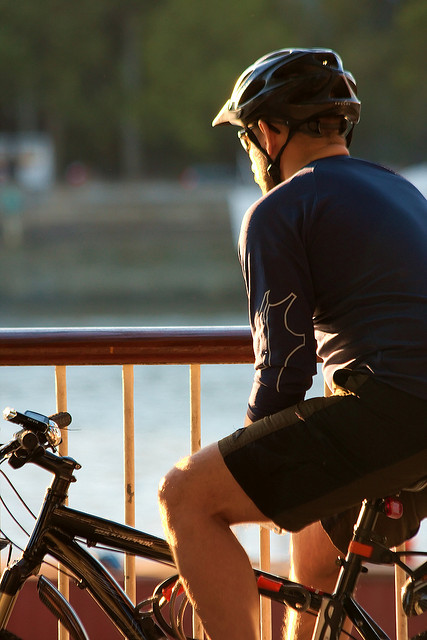To be able to cycle faster for longer, you have to be willing to train the muscles that are most important for your performance. Arguably, the most important muscle group you can train in order to become a better cyclist is your core. 
What is my “core?”
For beginning cyclists or those who are new to athletic training in general, your core muscle group will be the most important group to strengthen and maintain, no matter what activity or sport you wish to master. In his article “Do You Know What Your Core Really Is and What It Really Does?” adventure racer Jeff Kuhland defines your core as everything but your legs:
“Your core is a complex series of muscles, extending far beyond your abs, including everything besides your arms and legs. It is incorporated in almost every movement of the human body. These muscles can act as an isometric or dynamic stabilizer for movement, transfer force from one extremity to another, or initiate movement itself.”
Another definition from totalwomenscycling.com labels core muscles as the “muscles that hold you,” as opposed to the other muscles on your body, which “move you.” These include your abdominals, glutes, and your stablizing back and shoulder muscles.
How does strengthening my core improve my performance?
Cyclists with strong cores are able to maintain control over their bodies and bikes when they ride. If you have ever seen a cyclist pedaling full speed and rocking from side to side as they do so, that means they need to strengthen their core muscles. Your core allows you to control the force that you use in physical activity. It is surprising, then, since our core is used in almost every movement, that we forget or do not understand the importance of strengthening it. For the most part, we do not really understand how much we need our core muscles unless we have really strengthened or lost strength through inactivity.
How does strengthening my core prevent injury?
Lower back pain or hip pain caused by maintaining an aggressive riding position is one of the most common injuries that occurs to cyclists. While it is important to make sure that your bike fits you properly, it is equally as important to make sure that your core muscles are strengthened enough to protect your body. Weak core muscles can mean loss of the necessary power to get you through tough rides or the endurance necessary for long rides. This can lead to pain because other muscle groups will then try to overcompensate for the weakness in your core. Strengthening your major core muscle groups will stabilize your body and allow you to control your movements better when you get tired.
Core exercises
Bicycling.com offers great workout tips and routines for cyclists who are specifically interested in strengthening their cores and improving their performance. Here are three examples of exercises listed on their website.
1. Boxer Ball Crunch
“What It Works: Transverse abdominus, obliques, lower back”
“A. Lie with the middle of your back on a stability ball, your knees bent 90 degrees and your feet flat on the floor. Place your hands behind your head, but don’t pull on your neck.”
“B. Squeezing your belly button toward your spine, lift your upper back off the ball. Keeping your shoulders off the ball, trace a clockwise oval with your torso. Apply pressure with your lower back to keep the ball still through the entire motion. After 15 clockwise ovals, trace 15 counterclockwise.”
“Why It Works: Despite the straightforward motion of the bike, your body moves in three directions: forward as you head down the road, vertically as your legs pedal up and down, and laterally as your hips and upper body rock side to side. ‘This fluid, circular exercise builds control,’ says Street, and that helps you minimize lateral torsion and wasted motion.”
2. “Power Bridge”
“What It Works: Hip flexors, glutes, lower back”
A. “Lying on your back, bend your knees and place your heels near your glutes. Arms are at your sides, palms are down.”
B. “In one smooth motion, squeeze your glutes, raise your hips off the floor and push up from your heels to form a straight line from shoulders to knees; toes come off the floor slightly. Hold for two seconds. Keeping your toes raised, lower yourself three-quarters of the way to complete one rep. Do 20 repetitions.”
“Why It Works: In addition to stretching the hip flexors, often extremely stiff in cyclists, the bridge strengthens the link between your lower back and glutes.”
3. Hip Extension
What It Works: Lower back, hamstrings, glutes
A. “Lying with your hips and stomach on the stability ball, put your hands on the floor directly under your shoulders, and extend your legs with toes resting on the floor.”
B. “With a straight spine and shoulder blades back, as if you’re trying to make them touch, lift both legs off the floor, keeping them straight. If possible, raise them slightly higher than parallel to the floor. Hold for two seconds and lower. Do 20 reps.
Why It Works: This movement builds backside strength, for added efficiency on the second half of the pedal stroke.”
Photo Courtesy of Gary Knight and Creative Commons.
